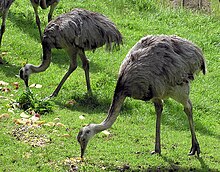| Rheids | |
|---|---|

| |
| Greater rhea, Rhea americana | |
| Scientific classification | |
| Domain: | Eukaryota |
| Kingdom: | Animalia |
| Phylum: | Chordata |
| Class: | Aves |
| Infraclass: | Palaeognathae |
| Clade: | Notopalaeognathae |
| Order: | Rheiformes |
| Family: | Rheidae Bonaparte, 1853[1] |
| Type species | |
| Rhea americana | |
| Genus | |
| |
| Synonyms | |
| |
Rheidae /ˈriːɪdiː/ is a family of flightless ratite birds which first appeared in the Paleocene.[2] It is today represented by the sole living genus Rhea, but also contains several extinct genera.[3]
Taxonomy[edit]
Order Rheiformes (Forbes, 1884) Furbringer, 1888 [Rheimorphae Bonaparte, 1849; Rheae Forbes 1884][4][5][6][7][8]
- Family †Opisthodactylidae Ameghino 1895
- Genus ?†Diogenornis de Alvarenga 1983 (Late Paleocene) – possibly a member of Casuariiformes instead.[9]
- Genus †Opisthodactylus Ameghino 1895 (Miocene) – rheid?
- Family Rheidae (Bonaparte 1849) Bonaparte, 1853
- Genus †Heterorhea Rovereto 1914 (Pliocene)
- Genus †Hinasuri Tambussi 1995
- Genus Rhea Brisson 1760
References[edit]
- ^ Brands, Sheila (14 August 2008). "Systema Naturae 2000 / Classification, Family Rheidae". Project: The Taxonomicon. Retrieved 4 February 2009.
- ^ Agnolin, Federico L. (July 2016) [2017]. "Unexpected diversity of ratites (Aves, Palaeognathae) in the early Cenozoic of South America: Palaeobiogeographical implications". Alcheringa: An Australasian Journal of Palaeontology. 41 (1): 101–111. doi:10.1080/03115518.2016.1184898. ISSN 0311-5518. S2CID 132516050.
- ^ Mayr, G. (2009). Paleogene fossil birds. Springer.
- ^ Haaramo, Mikko (2007). "Paleognathia - paleognathous modern birds". Mikko's Phylogeny Archive. Retrieved 30 December 2015.
- ^ "Taxonomic lists - Aves". Paleofile.com (net, info). Retrieved 30 December 2015.
- ^ "Part 7 - Vertebrates". Collection of genus-group names in a systematic arrangement. Retrieved 30 June 2016.
- ^ Çınar, Ümüt (November 2015). "01 → Pᴀʟᴇᴏɢɴᴀᴛʜᴀᴇ : Sᴛʀᴜᴛʜɪᴏɴɪfᴏʀᴍᴇs, Rʜᴇɪfᴏʀᴍᴇs, Cᴀsᴜᴀʀɪɪfᴏʀᴍᴇs, Aᴘᴛᴇʀʏɢɪfᴏʀᴍᴇs, Aᴇᴘʏᴏʀɴɪᴛʜɪfᴏʀᴍᴇs, Dɪɴᴏʀɴɪᴛʜɪfᴏʀᴍᴇs, Lɪᴛʜᴏʀɴɪᴛʜɪfᴏʀᴍᴇs, Tɪɴᴀᴍɪfᴏʀᴍᴇs & Rᴇfᴇʀᴇɴᴄᴇs". English Names of Birds. Retrieved 30 December 2015.
- ^ Brodkob, Pierce (1963). "1- Archaeopterygiformes through Ardeiformes". Biological sciences. Catalogue of fossil birds. 7 (4). Bulletin of the Florida State Museum: 180–293. Retrieved 30 December 2015.
- ^ Alvarenga, H. (2010). Diogenornis fragilis (Alvarenga, 1985) restudied: a South American ratite closely related to Casuariidae (Thesis).[full citation needed]



Well, that’s interesting to know that Psilotum nudum are known as whisk ferns. Psilotum nudum is the commoner species of the two. While the P. flaccidum is a rare species and is found in the tropical islands. Both the species are usually epiphytic in habit and grow upon tree ferns. These species may also be terrestrial and grow in humus or in the crevices of the rocks.
View the detailed Guide of Psilotum nudum: Detailed Study Of Psilotum Nudum (Whisk Fern), Classification, Anatomy, Reproduction